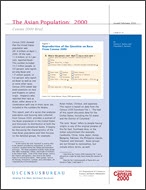Census 2000 Brief: The Asian Population: 2000
Census 2000 Brief: The Asian Population: 2000
Census 2000 showed that the United States population was 281.4 million on April 1, 2000. Of the total, 11.9 million, or 4.2 percent, reported Asian.1 This number included 10.2 million people, or 3.6 percent, who reported only Asian and 1.7 million people, or 0.6 percent, who reported Asian as well as one or more other races. Census 2000 asked separate questions on race and Hispanic or Latino origin. Hispanics who reported their race as Asian, either alone or in combination with one or more races, are included in the numbers for Asians.
This report, part of a series that analyzes population and housing data collected from Census 2000, provides a portrait of the Asian population in the United States and discusses its distribution at both the national and subnational levels. It begins by discussing the characteristics of the total Asian population and then focuses on the detailed groups, for example: Asian Indian, Chinese, and Japanese. This report is based on data from the Census 2000 Summary File 1.2 The text of this report discusses data for the United States, including the 50 states and the District of Columbia.3
The term “Asian” refers to people having origins in any of the original peoples of the Far East, Southeast Asia, or the Indian subcontinent (for example, Cambodia, China, India, Japan, Korea, Malaysia, Pakistan, the Philippine Islands, Thailand, and Vietnam). Asian groups are not limited to nationalities, but include ethnic terms, as well.
The first United States decennial census in 1790 collected data on race, but no distinction was made for people of Asian descent. Data have been collected on the Chinese population since the 1860 census and on the Japanese population since the 1870 census. The racial classification was expanded in the 1910 census to obtain separate figures on other groups such as Filipinos and Koreans. However, data on these other groups were collected on an intermittent basis through the 1970 census. Asian Indians were classified as White and the Vietnamese population was included in the “Other” race category in the 1970 census.
In the 1980 census, there were six separate response categories for Asians: Asian Indian, Chinese, Filipino, Japanese, Korean, and Vietnamese. These same six categories appeared on both the 1990 and Census 2000 questionnaires. Also, for Census 2000, a separate “Other Asian” response category was added with a write-in area for respondents to indicate specific Asian groups not included on the questionnaire.
__________
1 In this report, the term “reported” is used to refer to the answers provided by respondents, as well as responses assigned during the editing and imputation processes. The Asian population includes many groups who differ in language, culture, and length of residence in the United States. Some of the Asian groups, such as the Chinese and Japanese, have been in the United States for several generations. Other groups, such as the Hmong, Vietnamese, Laotians, and Cambodians, are comparatively recent immigrants.
2 Data from the Census 2000 Summary File 1 were released on a state-by-state basis during the summer of 2001.
3 Data for the Commonwealth of Puerto Rico are shown in Table 2 and Figure 3.
Related Information
Publication
Table
Table
Table
Population
Others in Series
Publication
Publication
Publication






